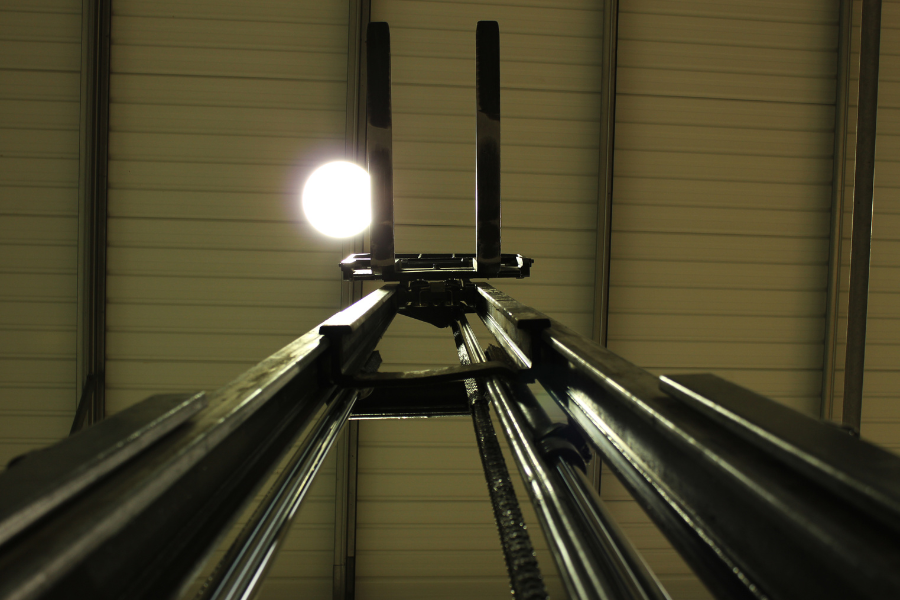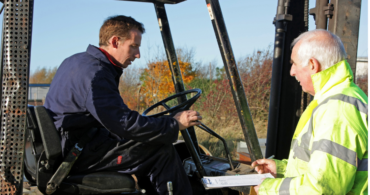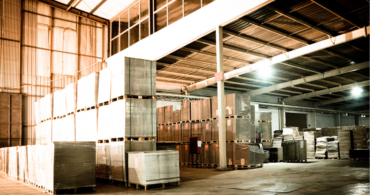When searching for the right lift truck for your operation, the forklift mast is an essential consideration.
A forklift mast, also known as an upright, is the vertical component that controls the raising, lowering and tilting of a load. While the forks support the cargo, it’s the mast that does all the heavy lifting.
Forklift anatomy: the mast
While the job of a forklift mast—raising and lowering cargo—is relatively straightforward, successfully achieving the task requires several complex components working in unison.
Rails
The rails are the most noticeable mast of forklift feature because they form the structure, or frame, of the mast. Every forklift has two stationary outer rails and at least one set of inner rails (or channels) that move up and down.
Forklift carriage
Every component used to secure a load connects to the forklift carriage, including the forks, load backrest and any accessories. The forklift carriage is not actually part of the mast. Instead, it attaches to a mount located between the mast’s rails.
Mast chains
When the inner rails begin to move, it’s the mast chains that lift the forklift carriage. One end of the mast chains is anchored to the carriage. The length then travels around a chain wheel. The other end of the chains is bolted to the inner rails. As the inner rails rise, the chair wheel turns—operating like a pulley—causing the chains to rise also and lift the carriage.
Hydraulic cylinders
Cylinders are hollow tubes that are open at one end so fluid can enter with a movable piston at the other end. Hydraulic cylinders are part of a forklift’s hydraulic system, which uses pressurized liquid to apply force.
Liquids are kind of weird. They’re neither solid nor gas, but they share characteristics of both. For example, if you jump into a pool vertically (straight up and down), you easily reach the bottom because the liquid moves around you (kind of like a gas). However, if you try to enter horizontally, like doing a belly flop, it initially feels like you landed on cement because the liquid can’t squish down (i.e., compress). A belly flop hurts because you tried to enter the pool too quickly and with too much surface area.
Hydraulic systems use this feature of liquids to transmit force. When hydraulic fluid pushes into the cylinder, pressure increases and the piston moves.
For a mast on a forklift hydraulic system, there are two types of cylinders. The first is lift cylinders, which provide the power to raise the rails, pull the lift chains and elevate the forklift carriage. The second is tilt cylinders, which enable the mast to lean forward and backward.
Mast features
Every forklift mast has four essential features.
Maximum fork height
The maximum fork height is the fork’s peak when fully extended. It is measured from the ground to the top of the forks. This measurement lets you know if a forklift can reach the top of your warehouse storage system.
Overall lowered height
The overall lowered height is measured from the ground to the top of the mast’s outer rails. This measurement lets you know if your vehicles can fit through your facility’s doorframes.
Overall raised height
Overall raised height is measured from the top of the load backrest to the ground when the mast is fully extended. Unlike maximum fork height, overall raised height helps you avoid potential obstructions when the mast is extended.
Free lift height
For a forklift to raise cargo as high as possible, the inner rails must extend to their maximum height. However, some masts can initially lift their forks without moving the inner rails. The tallest free lift height possible is near the top of the outer rails (this is known as full free lift). Knowing the free lift height is especially important for types of forklifts that operate in areas with limited overhead clearance, such as inside a shipping container or trailer.
Types of mast
Every lift truck, from the smallest warehouse forklift to the largest construction vehicle, has one of the following four mast types. The different forklift mast types are defined by their lifting height and each type has advantages and disadvantages.
Single-stage mast
Also known as: simplex mast, standard upright, view mast, V mast
A single-stage mast has the most limited lifting height. It also cannot free lift. So, even though it cannot lift cargo as high as the other types of mast, it also does not have the clearance of some mast types because the inner rails must rise to stack cargo. That’s why forklifts with single-stage masts are often used for outdoor applications and in areas where overhead clearance is not a concern. A benefit to this type of mast is that it has few components to obstruct the operator’s view, so poor visibility is rarely an issue.
Two-stage mast
Also known as: duplex mast, duplex upright, full free lift mast, FFL mast, free lift view mast, FV mast
Two-stage mast forklifts also tend to have good visibility since there aren’t many components blocking the driver’s view. These types of masts may or may not have the ability to free lift (when they do, they’re called free lift view masts or FV masts). A two-stage mast is often used for stacking and double stacking in indoor spaces with limited overhead clearance, such as loading and unloading trailers and box cars.
Three-stage mast
Also known as: triplex mast, three-stage upright mast, TSU mast, wide visible full free lift mast, FSV mast
A 3-stage mast forklift is one of the most common and versatile type of lift trucks. Most warehouse forklifts are three-stage mast vehicles. The forklift 3-stage mast uses two sets of inner rails and has full free lift capability.
Four-stage mast
Also known as: quadruplex mast, quad mast, QFV mast
The 4-stage forklift provides the highest possible reach. These masts utilize three sets of inner rails and a second set of chains to provide full free lift and four lift stages. A four-stage mast forklift is used in warehouses with extremely high racks and other industries where a significant reach is necessary.
At Texas Motive Solutions, we believe that mast height is not the only way to hit the highest highs with your forklift fleet. Our forklift battery repair team helps ensure your fleet operates to its peak potential. Please give us a call at (888) 316-2459 or fill out this form to learn about our services and discover everything we can do for you.


